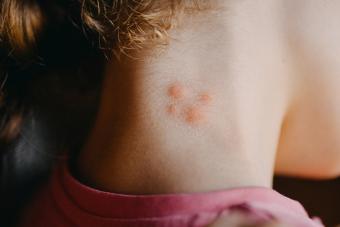
Allergic reaction rashes occur when you come into contact with one or more allergens that affect the skin. An angry rash is your skin's way of saying, 'No! Get that away from me!' These allergens do not necessarily have to come into contact only with the skin. Skin allergens can come from a variety of sources and affect you in many ways. But allergic rashes are generally fairly uncomfortable, so you'll want to identify the allergen and avoid it in the future.
Potential Causes of an Allergic Reaction Rash
An allergic reaction can affect nearly anyone at any time. Allergies can develop at any age - they may begin at birth or later in life. This means that there are a number of possible causes for an unexpected rash. The following are some of the most common reasons for allergic reaction rashes.
Plants
Poison ivy and poison oak are two common causes of body rashes. Another less common rash-inducing plant is poison sumac. Poison ivy and oak are easier to spot with their 'leaves of three,' but sumac leaves can come in bunches of 7-13. Take a look at some pictures so you can identify these allergens in the wild. While not everyone is allergic to these plants, a great number of people are.
After coming in contact with one of these troublemakers, you may experience anything from a mild reaction to severe symptoms, such as:
- Bumps, red patches, streaking or weeping blisters. (NOTE: fluids in blisters will not cause blisters to spread on you or to others).
- Flu or cold symptoms, including fever
- Itching
- Red rash within a few days of contact
- Swelling
Medications
Though medicines are usually a source of healing, in rare cases they can cause an allergic reaction. The symptoms of an allergic reaction to medication vary based on the medicine and the individual. A body rash is very common for this type of allergy, however. The most common culprits for causing skin rashes are:
- Antibiotics (like penicillin)
- Anticonvulsants (seizure medications)
- Chemotherapy
- NSAIDs (like Advil/Aleve)
If you suspect that you are having a reaction to a medication, either prescription or over-the-counter, you should speak to your healthcare provider to get personalized guidance, especially if the rash involves essential medications, such as chemotherapy.
Insect or Animal Bites
Bites from insects or animals can cause an allergic reaction to the skin. Depending on the severity of the reaction and whether other symptoms accompany the rash, it may be necessary to seek medical treatment to prevent infection, further symptoms or the spread of the rash.
Bites from spiders can cause rashes, but the symptoms can be much more severe if the spider is venomous, like the brown recluse or black widow. Some people are allergic to dog saliva, so a bite from that animal will cause a rash. When in doubt, seek medical attention if an animal bite causes concerning symptoms.
Insect Stings
In addition to bites, insect stings can trigger an allergic reaction. In some cases, this skin rash is one of many symptoms that could have serious health consequences. Some common rash-inducing bites include:
- Fire ants
- Honeybees
- Hornets
- Yellow Jackets
Treatment of rashes from a sting includes cleaning the area and application of an anti-inflammatory cream like hydrocortisone. Of course, if your allergic reaction begins to show more severe complications like extreme swelling or difficulty breathing, call 911 or go to the emergency room right away.
Other Allergic Reaction Triggers
There isn't a single cause that can be blamed for allergic reactions. Some factors, such as heredity, environment and medical history can explain some allergic reactions, but not all. Here are a few others that can trigger an allergic reaction or amplify its severity:
- Certain medical conditions, like asthma
- Emotional distress
- Injuries or surgery
- Skin sensitivity
- Stress
If a person has a mild to severe reaction to the first contact with an allergen, it is possible that subsequent contacts may increase in seriousness. This happens particularly with bee stings, so it's important to avoid future contact with known allergens when at all possible, especially if you wish to avoid potentially serious complications.
How to Manage an Allergic Rash
The first thing that you want to do if you suspect an allergic rash is to identify it. It can be somewhat difficult to identify this type of body rash. A rash occurring from an allergen will affect people differently and may not always appear in the same place on the body. Here are a few ways to recognize a rash.
- Blisters - Blistering of the skin may indicate a skin rash.
- Itchy skin - Many body rashes are itchy and painful.
- Swelling - Some rashes will cause skin to swell in areas.
- Warmth - Some rashes are warm to the touch.
- Welts and bumps - These can occur in a cluster or all over a region or area of the body. They may or may not appear red and puffy.
If you are unsure about a skin condition that has shown up, it's always best to communicate with your healthcare provider. In many cases, they can identify the cause quicky and make a recommendation for treatment.
In a small number of cases, an allergic reaction may cause not only a skin rash but a serious condition called anaphylactic shock or anaphylaxis. Those with anaphylaxis may experience drops in blood pressure, difficulty breathing and very pale skin. If untreated, this condition may cause death. If you or someone you know experience any of these symptoms, get medical help immediately.
Allergic reaction rashes are often mild and more irritating than medically harmful. But once you identify the culprit and determine a course of treatment, it becomes easier to manage - or better yet - to avoid altogether.







